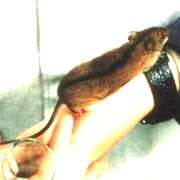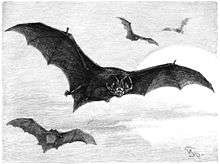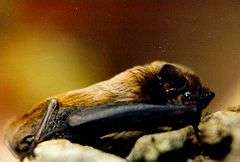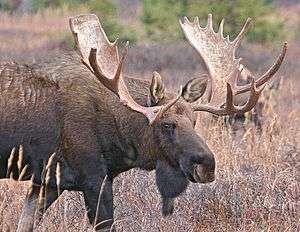List of mammals of Belarus
This is a list of the mammal species recorded in Belarus. There are 48 mammal species in Belarus, of which 0 are critically endangered, 2 are endangered, 4 are vulnerable, and 3 are near-threatened. 1 of the species listed for Belarus can no longer be found in the wild.[1]
The following tags are used to highlight each species' conservation status as assessed by the IUCN:
| EX | Extinct | No reasonable doubt that the last individual has died. |
| EW | Extinct in the wild | Known only to survive in captivity or as a naturalized populations well outside its previous range. |
| CR | Critically endangered | The species is in imminent risk of extinction in the wild. |
| EN | Endangered | The species is facing an extremely high risk of extinction in the wild. |
| VU | Vulnerable | The species is facing a high risk of extinction in the wild. |
| NT | Near threatened | The species does not meet any of the criteria that would categorise it as risking extinction but it is likely to do so in the future. |
| LC | Least concern | There are no current identifiable risks to the species. |
| DD | Data deficient | There is inadequate information to make an assessment of the risks to this species. |
Some species were assessed using an earlier set of criteria. Species assessed using this system have the following instead of near threatened and least concern categories:
| LR/cd | Lower risk/conservation dependent | Species which were the focus of conservation programmes and may have moved into a higher risk category if that programme was discontinued. |
| LR/nt | Lower risk/near threatened | Species which are close to being classified as vulnerable but are not the subject of conservation programmes. |
| LR/lc | Lower risk/least concern | Species for which there are no identifiable risks. |
Subclass: Theria
Infraclass: Eutheria
Order: Rodentia (rodents)
Rodents make up the largest order of mammals, with over 40 percent of mammalian species. They have two incisors in the upper and lower jaw which grow continually and must be kept short by gnawing. Most rodents are small though the capybara can weigh up to 45 kg (100 lb).
- Suborder: Sciurognathi
- Family: Castoridae (beavers)
- Genus: Castor
- European beaver Castor fiber NT
- Genus: Castor
- Family: Sciuridae (squirrels)
- Subfamily: Sciurinae
- Tribe: Pteromyini
- Genus: Pteromys
- Siberian flying squirrel Pteromys volans LR/nt
- Genus: Pteromys
- Tribe: Pteromyini
- Subfamily: Xerinae
- Tribe: Marmotini
- Genus: Marmota
- Bobak marmot Marmota bobak LR/cd
- Genus: Marmota
- Tribe: Marmotini
- Subfamily: Sciurinae
- Family: Gliridae (dormice)
- Subfamily: Leithiinae
- Genus: Dryomys
- Forest dormouse Dryomys nitedula LR/nt
- Genus: Muscardinus
- Hazel dormouse Muscardinus avellanarius LR/nt
- Genus: Dryomys
- Subfamily: Glirinae
- Genus: Glis
- Edible dormouse Glis glis LR/nt
- Genus: Glis
- Subfamily: Leithiinae
- Family: Cricetidae
- Subfamily: Arvicolinae
- Genus: Arvicola
- Water vole Arvicola terrestris LR/lc
- Genus: Clethrionomys
- Bank vole Clethrionomys glareolus LR/lc
- Genus: Microtus
- Field vole Microtus agrestis LR/lc
- Common vole Microtus arvalis LR/lc
- Tundra vole Microtus oeconomus LC
- Genus: Arvicola
- Subfamily: Arvicolinae
- Family: Muridae (mice, rats, voles, gerbils, hamsters, etc.)
- Subfamily: Murinae
- Genus: Apodemus
- Striped field mouse Apodemus agrarius LR/lc
- Yellow-necked mouse Apodemus flavicollis LR/lc
- Wood mouse Apodemus sylvaticus LC
- Ural field mouse Apodemus uralensis LR/lc
- Genus: Micromys
- Harvest mouse Micromys minutus LR/nt
- Genus: Apodemus
- Subfamily: Murinae
- Family: Castoridae (beavers)
Order: Lagomorpha (lagomorphs)
The lagomorphs comprise two families, Leporidae (hares and rabbits), and Ochotonidae (pikas). Though they can resemble rodents, and were classified as a superfamily in that order until the early twentieth century, they have since been considered a separate order. They differ from rodents in a number of physical characteristics, such as having four incisors in the upper jaw rather than two.
- Family: Leporidae (rabbits, hares)
- Genus: Lepus
- European hare Lepus europaeus LR/lc
- Mountain hare Lepus timidus LR/lc
- Genus: Lepus
Order: Erinaceomorpha (hedgehogs and gymnures)
The order Erinaceomorpha contains a single family, Erinaceidae, which comprise the hedgehogs and gymnures. The hedgehogs are easily recognised by their spines while gymnures look more like large rats.
- Family: Erinaceidae (hedgehogs)
- Subfamily: Erinaceinae
- Genus: Erinaceus
- Southern white-breasted hedgehog Erinaceus concolor LR/lc
- Genus: Erinaceus
- Subfamily: Erinaceinae
Order: Soricomorpha (shrews, moles, and solenodons)
The "shrew-forms" are insectivorous mammals. The shrews and solenodons closely resemble mice while the moles are stout-bodied burrowers.
- Family: Soricidae (shrews)
- Subfamily: Crocidurinae
- Genus: Crocidura
- Lesser white-toothed shrew Crocidura suaveolens LR/lc
- Genus: Crocidura
- Subfamily: Soricinae
- Tribe: Nectogalini
- Genus: Neomys
- Eurasian water shrew Neomys fodiens LR/lc
- Genus: Neomys
- Tribe: Soricini
- Genus: Sorex
- Laxmann's shrew Sorex caecutiens LR/lc
- Eurasian pygmy shrew Sorex minutus LR/lc
- Genus: Sorex
- Tribe: Nectogalini
- Subfamily: Crocidurinae
- Family: Talpidae (moles)
- Subfamily: Talpinae
- Tribe: Desmanini
- Genus: Desmana
- Russian desman Desmana moschata VU
- Genus: Desmana
- Tribe: Desmanini
- Subfamily: Talpinae
Order: Chiroptera (bats)
The bats' most distinguishing feature is that their forelimbs are developed as wings, making them the only mammals in the world naturally capable of flight. Bat species account for about 20% of all mammals.
- Family: Vespertilionidae
- Subfamily: Myotinae
- Genus: Myotis
- Bechstein's bat Myotis bechsteini VU
- Pond bat Myotis dasycneme VU
- Greater mouse-eared bat Myotis myotis LR/nt
- Natterer's bat Myotis nattereri LR/lc
- Genus: Myotis
- Subfamily: Vespertilioninae
- Genus: Barbastella
- Barbastelle Barbastella barbastellus VU
- Genus: Nyctalus
- Greater noctule bat Nyctalus lasiopterus LR/nt
- Lesser noctule Nyctalus leisleri LR/nt
- Genus: Barbastella
- Subfamily: Myotinae
Order: Carnivora (carnivorans)
There are over 260 species of carnivorans, the majority of which feed primarily on meat. They have a characteristic skull shape and dentition.
- Suborder: Feliformia
- Suborder: Caniformia
- Family: Canidae (dogs, foxes)
- Family: Ursidae (bears)
- Genus: Ursus
- Brown bear Ursus arctos LR/lc
- Genus: Ursus
- Family: Mustelidae (mustelids)
- Genus: Mustela
- Stoat Mustela erminea LR/lc
- Steppe polecat Mustela eversmannii LR/lc
- European mink Mustela lutreola EN
- Least weasel Mustela nivalis LR/lc
- European polecat Mustela putorius LR/lc
- Genus: Martes
- Beech marten Martes foina LR/lc
- Genus: Meles
- Eurasian badger Meles meles LR/lc
- Genus: Lutra
- European otter Lutra lutra NT
- Genus: Mustela
Order: Perissodactyla (odd-toed ungulates)
The odd-toed ungulates are browsing and grazing mammals. They are usually large to very large, and have relatively simple stomachs and a large middle toe.
- Family: Equidae (horses etc.)
- Genus: Equus
- Wild horse Equus ferus EW
- Genus: Equus
Order: Artiodactyla (even-toed ungulates)
The even-toed ungulates are ungulates whose weight is borne about equally by the third and fourth toes, rather than mostly or entirely by the third as in perissodactyls. There are about 220 artiodactyl species, including many that are of great economic importance to humans.
See also
- List of chordate orders
- List of prehistoric mammals
- Lists of mammals by region
- Mammal classification
- Mammals described in the 2000s
Notes
- ↑ This list is derived from the IUCN Red List which lists species of mammals and includes those mammals that have recently been classified as extinct (since 1500 AD). The taxonomy and naming of the individual species is based on those used in existing Wikipedia articles as of 21 May 2007 and supplemented by the common names and taxonomy from the IUCN, Smithsonian Institution, or University of Michigan where no Wikipedia article was available.
References
- "The IUCN Red List of Threatened Species: Mammals of Belarus". IUCN. 2001. Retrieved 22 May 2007.
- "Mammal Species of the World". Smithsonian National Museum of Natural History. 2005. Archived from the original on 27 April 2007. Retrieved 22 May 2007.
- "Animal Diversity Web". University of Michigan Museum of Zoology. 1995–2006. Retrieved 22 May 2007.







